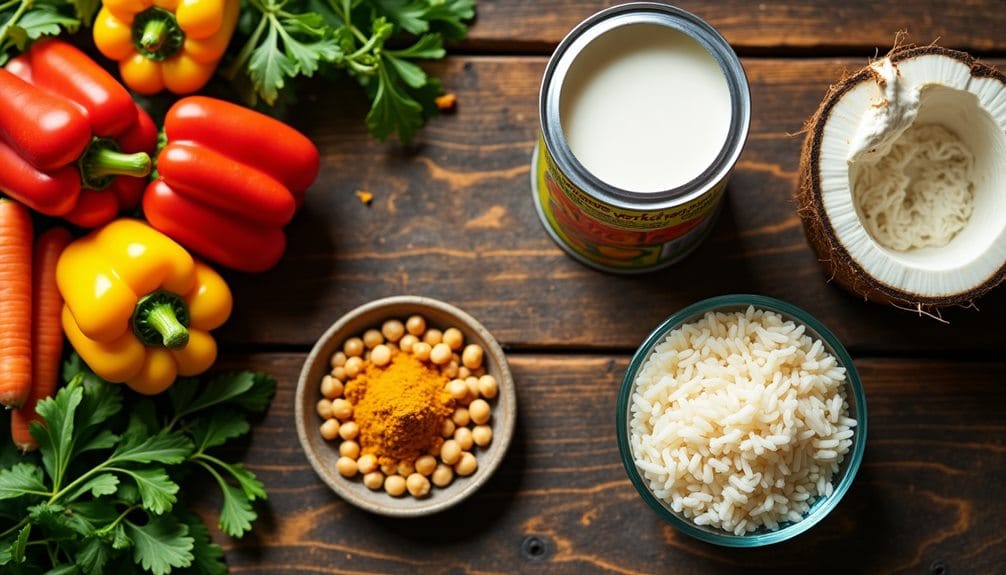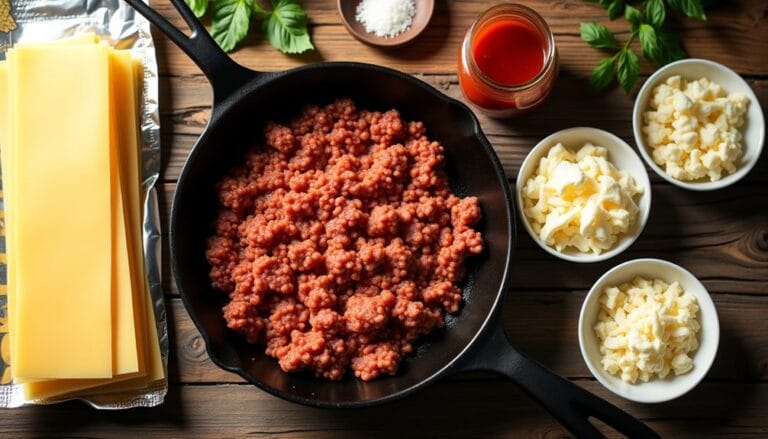Imagine you’re an artist, blending colors to create a masterpiece; Vegetable Curry with Rice bears the same principle. You blend a symphony of spices, vegetables, and grains, each element contributing its unique hue to an edible canvas. It’s not just about tossing ingredients into a pot; it’s about understanding the delicate balance between flavors, the dance of spices in the broth, and the harmony between the tender vegetables and the fluffy rice. Now, you might wonder, what makes this dish so special, and how can you perfect it in your kitchen? Let’s explore this together.
History
The history of vegetable curry with rice is as vibrant and diverse as the dish itself. Originating from India, the dish has traveled across continents, taking on new flavors and ingredients along the way. It’s been embraced by cultures worldwide, each adding their unique twist, making it a global phenomenon.
In India, it’s common to use a variety of local vegetables and spices. You might find curries with potatoes, peas, and cauliflower, or ones with okra and eggplant. The spices often include turmeric, cumin, and coriander, each lending their distinct flavor profiles.
As the dish migrated, adaptations occurred. In Thailand, for instance, they introduced coconut milk, making the curry creamier. In Japan, they incorporated a roux to thicken the sauce, creating a unique version of curry rice.
It’s important to note the rice’s role too. Basmati rice, with its aromatic and fluffy qualities, is traditionally paired with curry, enhancing the overall experience.
Recipe Cooking Steps
Vegetable Curry with Rice is a warm, delightful dish that promises to fulfill your taste buds with its amazing flavors and textures. This meal combines the aromatic spices of curry with a variety of vegetables and the hearty presence of rice, making it a perfect dish for those busy weeknights when you need a quick and yet nutritious meal. The beauty of this recipe is its flexibility, allowing you to utilize whatever vegetables you have on hand.
This recipe is not only packed with nutrient-dense vegetables, but it also incorporates chickpeas for an added boost of plant-based protein. The curry is a delectable mix of spices, tomatoes, and coconut milk, offering a creamy and satisfying base. The vegetables and chickpeas are simmered until tender in the curry, and the dish is served hot over a bed of fluffy basmati rice. It can be a wholesome meal on its own, or complement other dishes as a side.
Ingredients:
- 2 cups of mixed vegetables (like carrots, peas, bell peppers, and so on)
- 1 can of chickpeas, drained and rinsed
- 1 can of coconut milk
- 2 cups of basmati rice
- 2 tablespoons of curry powder
To make this dish, start by cooking the basmati rice as per the package instructions and then set it aside. In a large pan, cook the mixed vegetables and chickpeas over medium heat until they start to soften. Then add the curry powder and mix well until the vegetables are evenly coated. Pour in the coconut milk and bring the mixture to a simmer. Allow it to cook for about 20 minutes, until the vegetables are tender and the flavors have fully combined. Serve the curry hot over the cooked rice.
Some additional tips to enhance your Vegetable Curry with Rice experience include varying the vegetables according to what you have or what’s in season. This recipe is perfect for those leftover vegetables in your refrigerator. If you like a bit of heat, feel free to add some red pepper flakes or chopped fresh chili alongside the curry powder. Remember, the key to a great dish is tasting and adjusting the seasoning as needed. So, don’t forget to try the curry and tweak it to your liking. Enjoy cooking this delectable Vegetable Curry with Rice!
Step 1. Initial Rice Preparation

Before diving into the curry preparation, let’s get the rice cooking. You’ll want to use basmati rice for this dish due to its fragrant aroma and light, fluffy texture. Begin by measuring out 2 cups of rice. Rinse it under cold water until the water runs clear. This is an essential step as it removes excess starch, preventing the rice from being sticky.
Next, add the rinsed rice to a pot. For each cup of rice, you’ll need 1.5 cups of water, so pour in 3 cups. Bring the water to a boil, then reduce the heat to low and cover the pot. Let it simmer for about 15-20 minutes, or until all the water is absorbed and the rice is tender. Once it’s cooked, fluff the rice with a fork and set it aside.
Don’t worry if the rice seems undercooked at first. It will continue to steam in the pot even after you’ve turned off the heat. Remember, the key to perfect rice is patience, so resist the urge to stir it while it’s cooking. Now, you’re ready for the curry!
Step 2. Vegetable and Chickpea Sauté
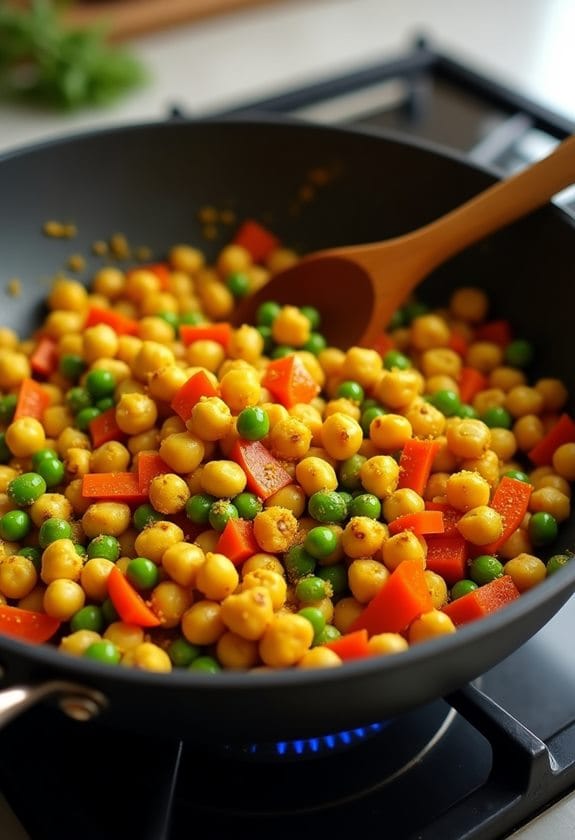
Start by grabbing a large pan and heating it up over medium heat. Add a splash of oil, then toss in your diced vegetables. You’re looking for a vibrant mix here – think bell peppers, carrots, peas, whatever you’ve got in the fridge. Once they start to soften, add in a can of drained and rinsed chickpeas. Stir it all together and let those flavors start to mingle.
Now, I want you to remember these three essential steps:
- Sauté your veggies until they’re just tender, not mushy.
- Don’t rush the chickpeas. Let them heat through and start to get a little crispy.
- Season as you go. A pinch of salt here, a grind of pepper there.
It’s all about building layers of flavors. Remember, this is your curry, so make it your own. Don’t be afraid to experiment with different vegetables or add some extra spice if you like it hot. Once everything’s cooked to your liking, take your pan off the heat. You’re ready for the next step – adding the curry and coconut milk.
Step 3. Adding Curry and Coconut Milk
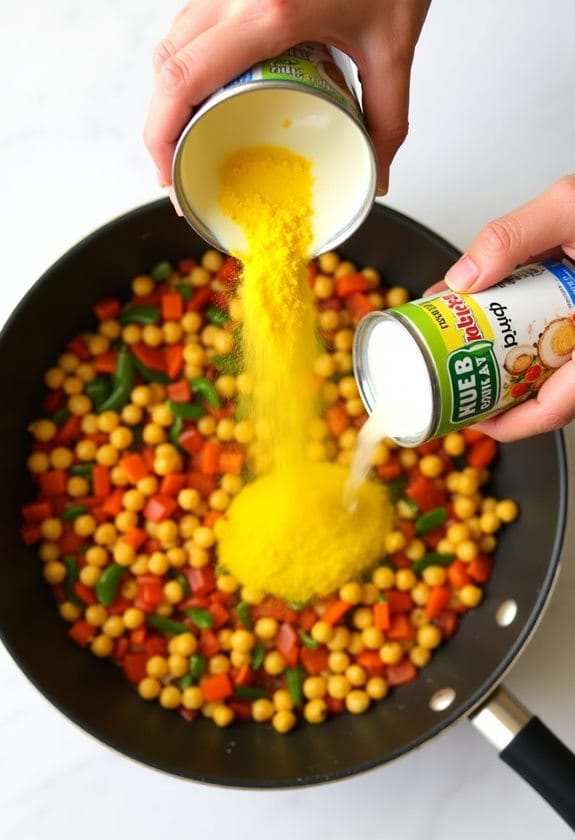
Diving into the heart of the dish, it’s time to add the curry and coconut milk. After sautéing your veggies and chickpeas, you’ll sprinkle in the curry powder. Stir it well, ensuring each piece is covered with this flavorful spice blend. It’s the curry that gives this dish its distinctive taste and color, so don’t be shy with it!
Next, you’ll pour in the coconut milk. This creamy liquid adds a rich depth of flavor and creates the sauce for your curry. You’ll notice the curry powder dissolving into the coconut milk, turning it a delightful golden color. As you stir, the combined aroma of the curry and coconut will fill your kitchen, hinting at the delicious meal to come.
Be sure to stir gently – you want to mix these ingredients well, but not at the cost of your freshly sautéed veggies. Once your curry and coconut milk are fully incorporated, you’ll move onto the next step. But for now, take a moment to appreciate that you’ve just created the flavorful base of your Vegetable Curry with Rice. Great job!
Step 4. Simmering Vegetable Curry Mixture
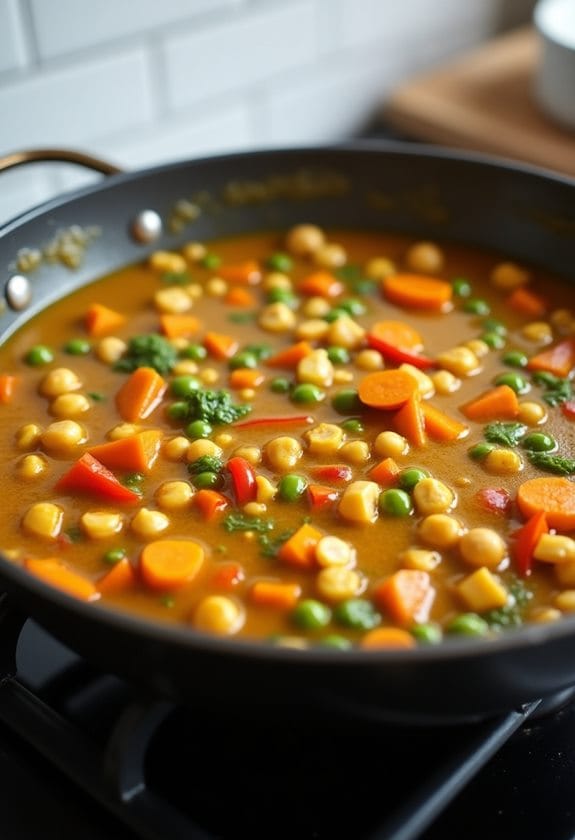
Now, it’s time to let your curry mixture do its magic. The simmering process is essential for the flavors to meld and the vegetables to reach the perfect tenderness.
First, reduce the heat to low after you’ve added the coconut milk, ensuring that the curry doesn’t boil aggressively. A gentle simmer is what you’re aiming for. Check your curry every few minutes, giving it a quick stir to prevent sticking or burning.
Second, let your curry simmer for about 20 minutes. This might seem like a while, but it’s necessary for the flavors to develop and intensify. Use this time to clean up your kitchen, set the table, or even start on dessert.
Third, remember to taste your curry as it simmers. Adjust the spices, adding more curry powder or a pinch of salt if needed. Remember, you’re the chef and your palate knows best.
To sum up, the simmering process involves:
- Setting the heat to low for a gentle simmer.
- Allowing the curry to cook for around 20 minutes.
- Tasting and adjusting the seasoning as needed.
There you have it! By following these steps, you’ll be on your way to a perfectly simmered vegetable curry.
Step 5. Curry Serving Over Cooked Rice
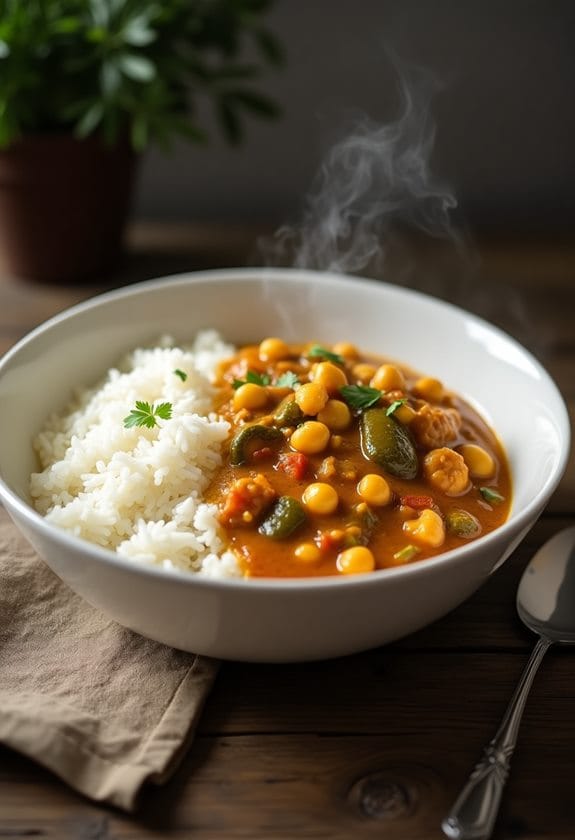
Once your curry has simmered to perfection, it’s time to serve. Lay out your warm, fluffy basmati rice on a plate or in a bowl. You’ve been patient and now that the rice is cooked to its ideal tender state, it’s ready to be the base for your vibrant curry.
Then, carefully ladle your creamy vegetable curry over the top. Don’t be shy, make sure every grain of rice gets coated with that rich, flavorful sauce. The curry should blanket the rice completely, transforming your humble grains into an exotic, mouth-watering feast.
Now comes the best part – it’s time to dig in. Grab your spoon and mix everything together. Each bite should be a perfect balance of fluffy rice and hearty curry. You’ll experience a burst of flavors from the spices, a hint of sweetness from the coconut milk, and a satisfying bite from the tender veggies and chickpeas.
New Recipe
- Pepperoni and Hot Honey PizzaTry the tantalizing twist of pepperoni pizza with hot honey, where sweet meets heat—how will it transform your taste buds?
Final Thoughts
While you may initially think that making Vegetable Curry with Rice is a complicated process, it’s actually quite simple and straightforward. This versatile dish, brimming with nutritious vegetables and protein-packed chickpeas, is not only tasty but also incredibly wholesome. It’s a one-pot wonder that’s sure to win hearts at your dinner table.
- Versatility: This dish embraces flexibility. Swap in veggies as per availability or personal preference. Got some leftovers? Toss them in!
- Nutrition: It’s a plant-based powerhouse loaded with essential nutrients. It’s a delightful fusion of health and taste!
- Ease: This curry is a breeze to prepare. With just one pan and a handful of ingredients, you’ve got a hearty meal!

